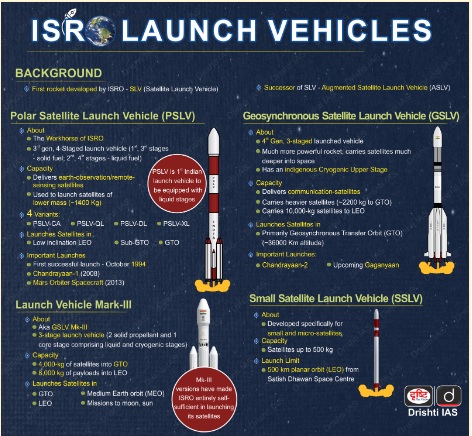Important Facts For Prelims
Reusable Launch Vehicle, RHUMI-1
- 05 Sep 2024
- 4 min read
Why in News?
India recently launched its first reusable hybrid rocket, RHUMI-1, developed by the Tamil Nadu-based start-up Space Zone India, to collect data for research purposes on global warming and climate change.
- The rocket, carrying 3 Cube Satellites and 50 PICO Satellites, was launched into a suborbital trajectory using a mobile launcher.
Note:
- Cube satellites are nano satellites that weigh between 1 to 10 kg.
- Pico satellites are smaller satellites, with weights ranging from 0.1 to 1 kg.
What are the Key Features of RHUMI-1?
- Hybrid Propulsion System: The RHUMI-1 integrates both solid and liquid propellants, enhancing efficiency and lowering operational costs.
- Adjustable Launch Angle: The engine allows for precise trajectory control with adjustable angles ranging from 0 to 120 degrees.
- Electrically Triggered Parachute System: It has advanced and eco-friendly descent mechanism that ensures safe recovery of rocket components, offering both cost-effectiveness and environmental benefits.
- Environmentally Friendly: It is entirely free of pyrotechnics (fireworks) and TNT (Trinitrotoluene), an odourless yellow solid used in explosives, highlighting its commitment to sustainability.
Note:
- Dr. A.P.J Abdul Kalam Students Satellite Launch Mission: In 2023, this mission involved over 2,500 students from government, tribal, and public schools across India who contributed to designing and constructing a student satellite launch vehicle capable of carrying a payload of 150 Pico Satellites research experiment cubes.
What are Reusable Launch Vehicles (RLVs)?
- About:
- Reusable Launch Vehicles (RLVs) are spacecraft designed to be launched, recovered, and launched again multiple times.
- Advantages:
- Cost Savings: Up to 65% cheaper than building a new rocket for every launch.
- Reduce Space Debris: By minimising discarded rocket components.
- Increased Launch Frequency: Lesser turnaround time enables the rocket to be used more frequently.
- Different from Multi-Stage Rocket:
- In a typical multi-stage rocket, the first stage is discarded after its fuel is exhausted to reduce weight, allowing the remaining stages to continue propelling the payload into orbit.
- However, RLVs recover and reuse the first stage. After separating from the upper stages, the first stage descends back to Earth using engines or parachutes for a controlled landing.

UPSC Civil Services Examination, Previous Year Question (PYQ)
Q. With reference to India’s satellite launch vehicles, consider the following statements: (2018)
- PSLVs launch the satellites useful for Earth resources monitoring whereas GSLVs are designed mainly to launch communication satellites.
- Satellites launched by PSLV appear to remain permanently fixed in the same position in the sky, as viewed from a particular location on Earth.
- GSLV Mk III is a four-staged launch vehicle with the first and third stages using solid rocket motors, and the second and fourth stages using liquid rocket engines.
Which of the statements given above is/are correct?
(a) 1 only
(b) 2 and 3
(c) 1 and 2
(d) 3 only
Ans: (a)




